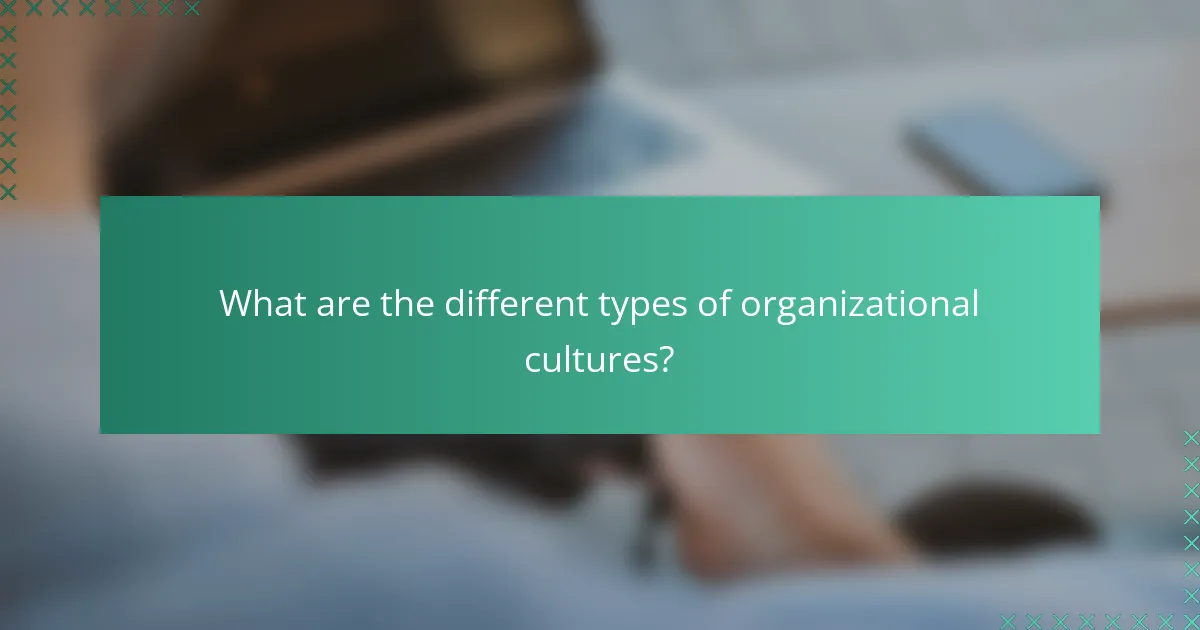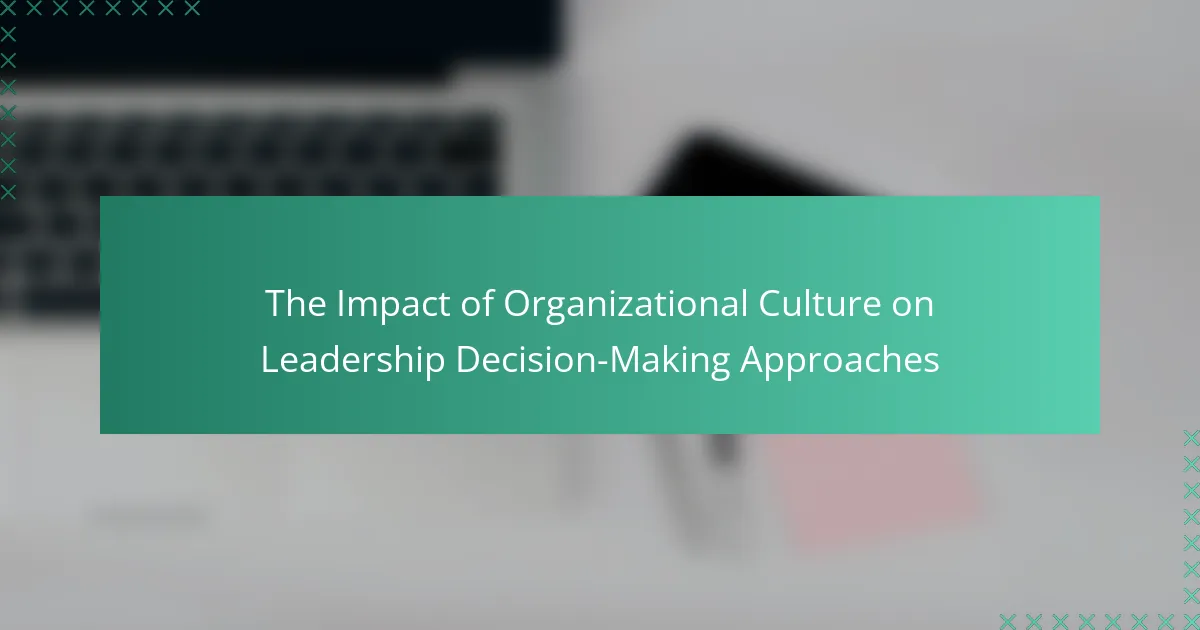Organizational culture is the collective values, beliefs, and behaviors that shape how decisions are made within an organization. This article explores the significant impact of organizational culture on leadership decision-making approaches, highlighting how different cultural types—such as clan, adhocracy, market, and hierarchy—affect leadership styles and decision-making processes. A strong organizational culture fosters alignment and consistency, while a weak culture can lead to ambiguity and conflict. Research indicates that leaders who align their decision-making with organizational culture enhance employee engagement and satisfaction, ultimately improving overall performance. The article emphasizes the importance of understanding cultural cues to tailor leadership strategies effectively.

What is the impact of organizational culture on leadership decision-making approaches?
Organizational culture significantly influences leadership decision-making approaches. It shapes the values, beliefs, and behaviors that leaders prioritize. A strong culture promotes alignment and consistency in decision-making. Conversely, a weak culture can lead to ambiguity and conflict. Research indicates that organizations with a collaborative culture foster participative decision-making. This encourages input from team members, enhancing creativity and innovation. In contrast, a hierarchical culture may result in top-down decision-making. This can limit diverse perspectives and slow down responsiveness. Overall, the alignment of culture and leadership style is crucial for effective decision-making.
How does organizational culture influence leadership styles?
Organizational culture significantly influences leadership styles. Culture shapes the values, beliefs, and behaviors within an organization. These elements dictate how leaders interact with their teams. For instance, a collaborative culture encourages participative leadership. In contrast, a hierarchical culture may promote autocratic leadership. Research indicates that organizations with strong cultures have leaders who align their styles with cultural norms. For example, a study by Schein (2010) highlights that leaders who embody cultural values foster trust and engagement. Thus, the alignment between organizational culture and leadership style is crucial for effective management.
What are the key elements of organizational culture that affect decision-making?
The key elements of organizational culture that affect decision-making include shared values, norms, and beliefs. Shared values guide employees’ actions and priorities within the organization. Norms establish expected behaviors, influencing how decisions are approached. Beliefs shape perceptions of what is possible and acceptable in decision-making contexts.
For instance, a culture that emphasizes collaboration may lead to more inclusive decision-making processes. In contrast, a culture focused on individual achievement may foster quicker, more unilateral decisions. Research indicates that organizations with strong, positive cultures often experience better decision-making outcomes. According to a study by Kotter and Heskett, companies with adaptive cultures outperform their competitors by 200% over 11 years, highlighting the direct impact of culture on decision-making effectiveness.
How do different leadership styles adapt to various organizational cultures?
Different leadership styles adapt to various organizational cultures by aligning their approaches with the values and norms of the culture. For example, transformational leaders inspire and motivate employees, fitting well in innovative cultures that value creativity. In contrast, transactional leaders focus on structure and rewards, which suits hierarchical cultures emphasizing order and compliance.
Additionally, servant leaders prioritize employee well-being, making them effective in cultures that value collaboration and community. Research shows that organizations with adaptive leadership styles often experience higher employee engagement and satisfaction. A study by Goleman (2000) highlights how emotional intelligence in leadership can enhance adaptability to different cultural contexts. Thus, the effectiveness of a leadership style hinges on its compatibility with the underlying organizational culture.
Why is understanding this impact important for organizations?
Understanding the impact of organizational culture on leadership decision-making is crucial for organizations. It shapes how leaders communicate and make choices. A strong culture fosters collaboration and innovation. This alignment can enhance employee engagement and retention. Research shows that organizations with positive cultures outperform their competitors. For example, companies in the Fortune 100 Best Companies to Work For list have higher stock performance. This evidence underscores the importance of culture in driving successful leadership outcomes.
What are the potential consequences of misalignment between culture and leadership?
Misalignment between culture and leadership can lead to decreased employee morale. When leadership does not reflect the organization’s values, employees may feel disconnected. This disconnect can result in lower productivity levels. Employees may also exhibit increased turnover rates. A study by the Society for Human Resource Management found that cultural misalignment can cost organizations significantly in recruitment and training. Additionally, misalignment can hinder effective communication within the organization. Poor communication can lead to misunderstandings and conflict. Ultimately, these consequences can impact overall organizational performance and success.
How can awareness of this impact improve organizational effectiveness?
Awareness of the impact of organizational culture on leadership decision-making can significantly improve organizational effectiveness. Understanding this relationship allows leaders to align their decisions with the values and norms of the organization. When leaders are aware of cultural influences, they can foster a more inclusive environment. This inclusivity can enhance employee engagement and productivity. Research shows that organizations with strong cultural alignment experience higher performance levels. For instance, a study by Kotter and Heskett found that firms with adaptive cultures had 200% higher stock market returns over ten years. Thus, awareness leads to informed decision-making that aligns with organizational goals.

What are the different types of organizational cultures?
There are several types of organizational cultures. These include clan culture, adhocracy culture, market culture, and hierarchy culture. Clan culture emphasizes collaboration and a family-like atmosphere. Adhocracy culture values innovation and risk-taking. Market culture focuses on competitiveness and achieving results. Hierarchy culture relies on structure and control. Each type influences leadership decision-making approaches differently. For example, clan cultures may encourage participative leadership, while market cultures might promote a more directive style.
How do these cultures shape leadership decision-making?
Cultures shape leadership decision-making by influencing values, communication styles, and approaches to authority. Different cultures prioritize various aspects, such as collaboration or individualism. For instance, collectivist cultures often emphasize consensus and group harmony in decision-making. In contrast, individualistic cultures may favor assertiveness and personal accountability. Research shows that leadership styles align with cultural norms. A study by Hofstede indicates that cultures with high power distance accept hierarchical decision-making. Conversely, low power distance cultures encourage egalitarian approaches. These cultural factors directly affect how leaders communicate, delegate, and resolve conflicts.
What characteristics define a strong organizational culture?
A strong organizational culture is defined by shared values, beliefs, and behaviors among employees. This culture fosters a sense of belonging and commitment. Clear communication is essential in strong cultures. It promotes transparency and trust within the organization. Employee engagement is another critical characteristic. Engaged employees are more productive and aligned with company goals. Adaptability is also vital. Organizations with strong cultures can navigate change effectively. Leadership plays a significant role in shaping culture. Leaders model behaviors that reinforce cultural values. Lastly, recognition and reward systems support and enhance the cultural environment. These characteristics collectively contribute to a resilient and effective organizational culture.
How do specific cultural types, such as hierarchical or innovative cultures, influence decisions?
Hierarchical cultures influence decisions by emphasizing authority and structured processes. In these cultures, decision-making often follows a top-down approach. Leaders make choices based on established protocols and directives. This can lead to consistency in decisions but may stifle creativity.
Conversely, innovative cultures encourage flexibility and collaboration in decision-making. In these environments, input from various team members is valued. This approach fosters creativity and adaptability. Decisions are often made through brainstorming and consensus-building.
Research shows that organizations with innovative cultures tend to respond faster to market changes. For instance, a study by McKinsey & Company found that companies with strong innovative cultures outperform their competitors in growth metrics.
What role does communication play in the relationship between culture and leadership?
Communication serves as a vital link between culture and leadership. It facilitates the exchange of values and beliefs that shape organizational culture. Effective communication allows leaders to articulate their vision and align it with cultural norms. This alignment fosters trust and engagement among team members. Additionally, communication helps leaders to adapt their strategies based on cultural feedback. Research indicates that organizations with strong communication practices see improved leadership effectiveness. For instance, a study by Zorn et al. (2011) highlights that transparent communication enhances employee commitment, directly impacting leadership success.
How can effective communication enhance decision-making processes?
Effective communication enhances decision-making processes by ensuring clarity and understanding among stakeholders. Clear communication reduces misunderstandings and misinterpretations. It allows team members to share diverse perspectives and insights. This exchange of information fosters collaboration and creativity. When everyone is informed, decisions are made based on accurate data. Research shows that organizations with effective communication have higher employee engagement. According to a study by the Harvard Business Review, companies with strong communication practices outperform their peers by 20-25%. Therefore, effective communication is crucial for informed and timely decision-making.
What are the barriers to communication that can affect leadership decisions within different cultures?
Barriers to communication affecting leadership decisions across cultures include language differences, non-verbal misinterpretations, and varying cultural norms. Language differences can lead to misunderstandings and misinterpretations of messages. Non-verbal cues, such as gestures and [censured] expressions, may vary significantly between cultures, causing confusion. Cultural norms dictate acceptable communication styles, which can clash and hinder effective dialogue. Additionally, hierarchical structures in some cultures may restrict open communication, limiting feedback. These barriers can ultimately lead to poor decision-making and strained relationships within diverse teams. Research indicates that organizations with high cultural awareness experience improved communication and decision-making processes.

How can leaders adapt their decision-making approaches based on organizational culture?
Leaders can adapt their decision-making approaches by aligning them with the values and norms of the organizational culture. Understanding the culture helps leaders determine how decisions will be received. For instance, in a collaborative culture, leaders may prioritize consensus-building in their decision-making. In contrast, in a hierarchical culture, leaders might rely more on authoritative decision-making.
Research indicates that leaders who adapt to their organizational culture can enhance employee engagement and satisfaction. A study by Schein (2010) highlights that cultural alignment can lead to more effective decision-making processes. By recognizing cultural cues, leaders can tailor their strategies to support organizational goals. This adaptability fosters a sense of belonging and improves overall performance.
What strategies can leaders employ to align their decisions with organizational culture?
Leaders can employ several strategies to align their decisions with organizational culture. First, they should clearly define the organization’s core values. This creates a framework for decision-making that reflects the culture. Second, leaders can engage employees in open communication. This fosters a sense of belonging and encourages feedback on decisions. Third, training programs can be implemented to reinforce cultural values. These programs help employees understand how their roles align with the organization’s mission. Fourth, leaders can model desired behaviors. By demonstrating commitment to the culture, they set a standard for others. Lastly, recognizing and rewarding behaviors that exemplify the culture can motivate employees. These strategies create a cohesive environment that supports alignment between decisions and organizational culture.
How can leaders assess the cultural landscape before making decisions?
Leaders can assess the cultural landscape by conducting thorough cultural assessments. This involves gathering data on employee attitudes, values, and behaviors. Surveys and interviews can provide insights into the prevailing organizational culture. Additionally, leaders should analyze existing cultural artifacts, such as company policies and communication styles. Observing interactions within teams can reveal underlying cultural dynamics. Research shows that understanding these elements is crucial for informed decision-making. A study by Schein (2010) emphasizes the importance of aligning decisions with cultural values to enhance organizational effectiveness.
What best practices can leaders follow to foster a culture that supports effective decision-making?
Leaders can foster a culture that supports effective decision-making by encouraging open communication. This involves creating an environment where team members feel safe to express their ideas and concerns. Regular feedback sessions can help in this regard. Leaders should also promote collaboration among team members. Collaborative efforts often lead to diverse perspectives, enhancing decision quality.
Another best practice is providing training and resources for decision-making processes. Educated employees are more likely to make informed choices. Establishing clear decision-making frameworks can guide employees in their processes. Consistency in these frameworks leads to better outcomes over time.
Leaders should recognize and reward effective decision-making. This reinforces the importance of sound choices within the organization. Finally, leaders must model effective decision-making themselves. Their actions set a standard for others to follow. These practices collectively contribute to a robust decision-making culture.
What are some common challenges leaders face in this context?
Leaders face several common challenges in the context of organizational culture impacting decision-making. One challenge is aligning team values with organizational goals. Misalignment can lead to disengagement and reduced productivity. Another challenge is managing resistance to change. Employees may be hesitant to adopt new practices that conflict with established cultural norms. Additionally, leaders often struggle with communication barriers. Clear messaging is essential for effective decision-making but can be hindered by varying interpretations of culture. Furthermore, leaders face the challenge of fostering inclusivity. A culture that lacks diversity can limit perspectives and innovation. Lastly, leaders must navigate the complexities of decision-making under pressure. High-stakes situations can exacerbate cultural conflicts and hinder effective outcomes.
How can leaders overcome resistance to change within an organizational culture?
Leaders can overcome resistance to change within an organizational culture by fostering open communication. This involves actively listening to employees’ concerns and feedback. Transparency about the reasons for change builds trust. Leaders should also involve employees in the change process. This inclusion can increase their commitment to new initiatives. Providing training and resources helps employees adapt to changes. Recognizing and rewarding flexibility can motivate positive behavior. Research shows that organizations with strong communication strategies experience less resistance to change. For example, a study by Kotter and Schlesinger highlights the importance of participation in reducing resistance.
What tools and frameworks can assist leaders in navigating cultural challenges during decision-making?
Tools and frameworks that assist leaders in navigating cultural challenges during decision-making include cultural assessment tools, the Hofstede’s Cultural Dimensions Theory, and the GLOBE Study. Cultural assessment tools help identify cultural strengths and weaknesses within an organization. The Hofstede’s Cultural Dimensions Theory provides a framework for understanding cultural differences across various dimensions, such as individualism versus collectivism. The GLOBE Study offers insights into how culture impacts leadership behaviors and organizational practices. These tools and frameworks enable leaders to make informed decisions by considering cultural contexts. By applying them, leaders can enhance communication and collaboration in diverse teams.
What practical tips can leaders implement for effective decision-making in alignment with culture?
Leaders can implement several practical tips for effective decision-making aligned with organizational culture. First, they should actively engage employees in the decision-making process. This fosters a sense of ownership and aligns decisions with cultural values. Second, leaders must communicate clearly and consistently about decisions and their rationale. Transparency builds trust and reinforces cultural alignment. Third, they should seek diverse perspectives to ensure that decisions reflect the organization’s cultural diversity. This can lead to more innovative solutions. Fourth, leaders need to model cultural values in their decisions. This sets a standard for behavior and reinforces the desired culture. Lastly, they should regularly review and adapt decision-making processes to ensure they remain aligned with evolving cultural dynamics. These strategies enhance decision-making effectiveness while promoting a strong organizational culture.
The main entity of the article is organizational culture and its impact on leadership decision-making approaches. The article examines how organizational culture shapes leadership styles, influences decision-making processes, and affects overall organizational effectiveness. Key elements such as shared values, norms, and beliefs are highlighted as critical factors in determining how decisions are made within different cultural contexts. Additionally, the article addresses the consequences of misalignment between culture and leadership, strategies for fostering a supportive decision-making culture, and practical tips for leaders to enhance their decision-making in alignment with organizational culture.
